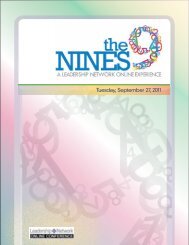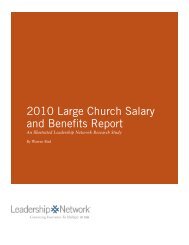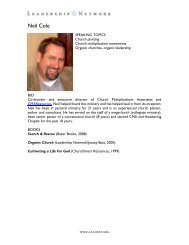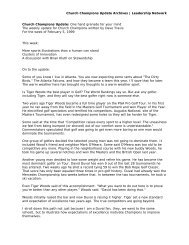ARE WE A PEOPLE AT HALF TIME? - Leadership Network
ARE WE A PEOPLE AT HALF TIME? - Leadership Network
ARE WE A PEOPLE AT HALF TIME? - Leadership Network
Create successful ePaper yourself
Turn your PDF publications into a flip-book with our unique Google optimized e-Paper software.
e breeding grounds for personal renewal<br />
and human connectedness. Yet they stay<br />
alive and purposeful—and true to God’s<br />
will, as they see it—only by growing: by<br />
remaining vigilantly open and aggressively<br />
attractive to the world.<br />
Following Saint Paul’s first letter to the<br />
Corinthians, they seek to be “all things to<br />
all men”—not forgetting the rest of the<br />
sentence, “that some might be saved.” By<br />
taking on roles as various as those of the<br />
Welcome Wagon, the USO, the Rotary, the<br />
quilting bee, the book club, the coffee<br />
shop, and the mixer—and, of course, the<br />
traditional family and school—they have<br />
become much more than the traditional<br />
churches that many Americans grew up in<br />
and have long since lost. Belonging to<br />
Mariners or any other large church conveys<br />
membership in a community, with its<br />
benefits of friends and solace and purpose<br />
and the deep satisfaction of service to others.<br />
When we were talking in his office one<br />
day, Beshore described the Next Church<br />
strategy as succinctly as I was to hear it.<br />
“We give them what they want,” he said,<br />
“and we give them what they didn’t know<br />
they wanted—a life change.”<br />
“WHO IS OUR CUSTOMER”<br />
Bob Buford, a Texas businessman and<br />
author who became one of my guides in<br />
the world of the Next Church, showed me<br />
a handsome framed woodcut on the wall of<br />
his study one day. It read, “What is our<br />
business Who is our customer What<br />
does the customer consider value”<br />
The words come from Peter Drucker,<br />
the high priest of management theory, who<br />
has recognized the pastoral-church phenomenon<br />
as one of the signal events of the<br />
late twentieth century—part of a sweeping<br />
and spontaneous reorganization of social<br />
structures and relationships.<br />
“What is our business” That would be<br />
FDFX. I saw this mysterious acronym on a<br />
T-shirt, and eventually figured out what it<br />
meant. It comes from a chronically<br />
invoked Next Church mission statement:<br />
turning irreligious or unchurched people<br />
into Fully Devoted Followers of Christ.<br />
“Who is our customer” That would be<br />
Baby Boomers, mostly. This is not exactly<br />
niche marketing. The postwar birth cohort,<br />
after all, is the biggest and currently the<br />
most powerful one out there, the flushest<br />
and the most fecund. Boomers are a needy<br />
and a motivated bunch—with lots of experience<br />
in shopping for spiritual comfort.<br />
Churches like Mariners are drawing a<br />
flock of previously unchurched or unhappily<br />
churched people by being relentlessly<br />
creative about developing forms of worship—most<br />
symbolically and definingly,<br />
music—that are contemporary, accessible,<br />
“authentic.” Next Church services are multimedia<br />
affairs. Overhead projectors allow<br />
the preacher to sketch his point the way a<br />
teacher would on a chalkboard, or to illustrate<br />
his message with a cartoon, an apt<br />
quotation, or a video clip. Lyle E. Schaller,<br />
an independent scholar and<br />
the author of dozens of<br />
books on the large-church<br />
movement, suggests that<br />
these are the descendants of<br />
the stained-glass window,<br />
another nonverbal storytelling<br />
device.<br />
A leading pastor in this<br />
movement, Leith Anderson,<br />
of Wooddale Church, in<br />
Eden Prairie, Minnesota,<br />
likes to talk about “reading<br />
the culture” and “translating<br />
the culture.” The culture is<br />
suspicious of old-church<br />
“European” atmospherics,<br />
ritual, and language—suspicious<br />
of old institutions in<br />
general.<br />
Some of these churches<br />
“are dramatizing a truth that<br />
missionaries have known<br />
for decades,” the church<br />
scholar George Hunter<br />
writes in his new book,<br />
Church for the Unchurched.<br />
“To reach non-Christian populations, it is<br />
necessary for a church to become culturally<br />
indigenous to its ‘mission field’”—<br />
whether that is Asia, Africa, Latin<br />
America, or Exurbia. “When the church’s<br />
communication forms are alien to the host<br />
population, they may never perceive that<br />
Christianity’s God is for people like them.”<br />
Anderson, in his recent book, A<br />
Church for the 21st Century, put this in<br />
perspective. “While the New Testament<br />
speaks often about churches, it is surprisingly<br />
silent about many matters that we<br />
associate with church structure and life.<br />
There is no mention of architecture, pulpits,<br />
lengths of typical sermons, or rules<br />
for having a Sunday school. Little is said<br />
about style of music, order of worship, or<br />
times of church gatherings. There were no<br />
Bibles, denominations, camps, pastors’<br />
conferences, or board meeting minutes.<br />
Those who strive to be New Testament<br />
churches must seek to live its principles<br />
and absolutes, not reproduce the details.”<br />
It is music, more than any other issue<br />
or symbol, that divides congregations on<br />
the cusp of growth. The<br />
pipe organ, the old hymnal,<br />
and the robed choir are<br />
emblems of continuity and<br />
cohesion to those who<br />
uphold tradition, of encrustation<br />
and exclusion to<br />
those who don’t. Whether a<br />
church uses contemporary<br />
music or not defines which<br />
kind of people it wants.<br />
When it uses contemporary<br />
music, it’s saying it wants<br />
unchurched people—particularly<br />
those of childbearing<br />
and child-rearing age.<br />
Even the most stubbornly<br />
traditional churches,<br />
if they have any critical<br />
mass at all, are putting children’s<br />
education, child<br />
care, and teen activities up<br />
there with music as essential<br />
ingredients to attract<br />
Boomer families and, in the<br />
years ahead, the following<br />
generation, usually called<br />
Busters (for the post-Boom baby “bust,”<br />
born after 1964).<br />
Its means may be market-driven, culturally<br />
sensitive, and cutting-edge, but this<br />
does not make the Next Church “progressive”<br />
or “liberal” on the fundamentals.<br />
3







